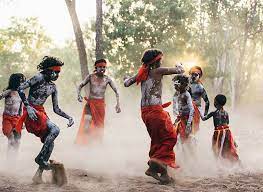Help keep family & friends informed by sharing this article
abc.net.au/news/giant-aboriginal-art-years-in-making-sprouting-acoss-wa/102711838
Link copiedCOPY LINKSHARE
It’s taken years and patience to create this gigantic Aboriginal artwork.
Amid the vast landscape of southern Western Australia, giant animal geoglyphs are popping up in bushland.
Only visible from the air, the artworks have been designed by traditional owners of the area and are helping bring the landscape back to life.
Goreng Noongar leader and Elder Eugene Eades says it’s all about healing country.
“It brings joy back to me,” he said.
“When our people lived off the land using agricultural practices, maintaining the land and looking after and caring for plants and animal life.”
The Karda, or goanna, near the Stirling Range was designed by Erol Eades, Eugene Eades’s nephew, and has cultural connection to the land.
“It represents Noongar people that have the goanna as their totem,” Mr Eades said.
“In the summer when you come here this place is saturated with goannas.”
Planted more than six years ago, the Karda has now taken shape, and there are several more artworks across the region, each with a different meaning.
Each represents a totem and a story connected to the country, like the Ngow (mallee bird) in Nowanup, the Yonga (kangaroo) planted near Jerramungup and the Karta-Wongkin-Jini (place where people come together) in Nowanup.
But they serve a larger purpose, and these artworks have been strategically planted in an effort to conserve the land.
‘It bring us joy’
The Gondwana Link program is a collaboration that includes local Noongar communities, Greening Australia and a range of other contributors.
The program involves purchases of land in southern WA for eco-cultural restoration.
With the help and guidance of local Aboriginal community leaders and rangers, the team have been able to design and plant these massive artworks.
The team then planted vegetation suitable to the landscape.
Mr Eades says being back on country and caring for the living art reminds him of how things should be.
“It is a great legacy we are leaving behind here for many people to celebrate and share and visit,” he said.








